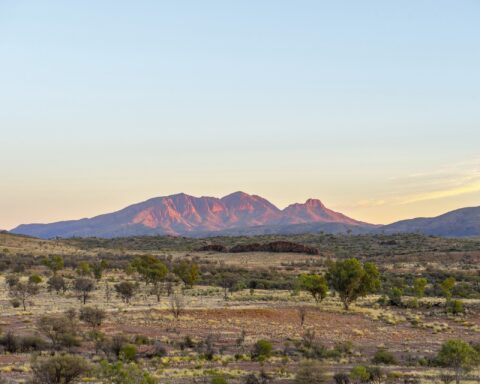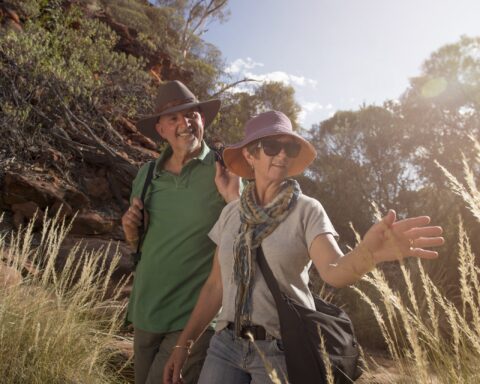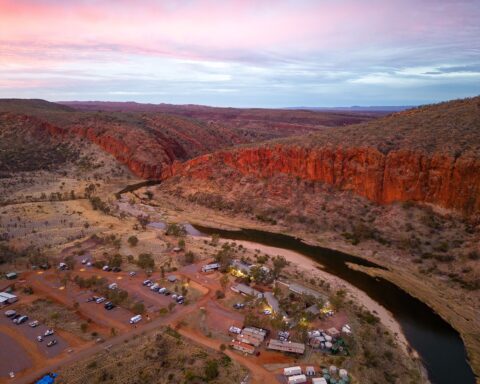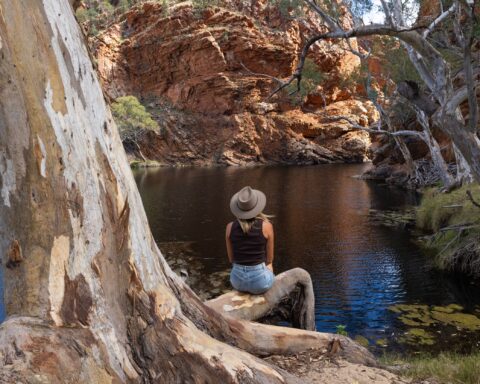If you venture into the heart of Australia, in the centre of the country you will find Alice Springs in the Northern Territory. Despite its extremely remote location, Alice Springs is a modern town with many of the conveniences of much larger towns. The rich culture is a mix of western and Aboriginal, and Alice Springs is home to many Indian, Vietnamese, African and German locals, as well as Australians. Many Aboriginals from a wide area of remote communities will travel to Alice Springs for conveniences, and as a result, a large number of different Aboriginal groups are also represented here. The result is a vibrant and diverse community which embraces the variety of different cultures and backgrounds, and the unique identity of the town.
Aboriginal culture
Alice Springs is known as Mparntwe to the traditional owners, the Arrernte people. They own much of the surrounding land and have inhabited the area for thousands of years. They were the first inhabitants of Alice Springs, and there are many sacred sites in the area. The Arrente language means much more to them than just the way that they speak – it reflects who they are, their cultural identity, and their belief systems. Around 25% of the Alice Springs population speak Arrente as a first language.
Dreamtime Stories
Dreamtime is a crucial aspect of Aboriginal culture, and it refers to the very beginning when it is believed that the Spirits created the land and the people, and gave each tribe its land. Dreamtime relates to the most important beliefs of Aboriginal people, including everything from their spiritual beliefs to their existence. It is believed that the ancestors created particular sites so that the Aboriginal people would know which places were sacred, and respecting these places is essential. These stories are passed down from generation to generation, and they form the basis for Aboriginal culture and determine how Aboriginal people live their lives.
The Yeperenye (caterpillar) Dreaming story tells us how the Alice Springs region was created by giant caterpillars. The caterpillars lost a battle with their enemies, the stink bugs, and then the caterpillars became the beautiful ridges of the East and West MacDonnell Ranges, which shelter the town. The gaps in the range are said to have been created when caterpillars’ heads were bitten off by stink bugs.
Sacred Sites
Alice Springs consists of a unique mix of developed areas and sacred sites, and the sacred sites are spiritual centres for animals and plants as well as Aboriginal people. A sacred site is formed by events told in Dreamtime stories, and ceremonies relating to the event may be held at the sites or close by. Some sacred sites are male sites, which females are forbidden from entering, and some are female sites which men are not allowed to enter. Alice Springs and the surrounding area are home to over 100 sacred sites, making it one of the most densely populated areas for sacred sites in the Northern Territory. Aboriginals believe that any damage or disturbance to these sites can lead to serious danger for the community, however many sacred sites around Alice Springs have already been lost to development. This makes the remaining sites even more precious.
The Araluen Precinct is set amongst several sites of cultural significance. These include two hills known as the Yaye and the Yaye Akweke – big sister hill and little sister hill, as well as a sacred corkwood tree which is 300 years old. Dreamtime stories tell us that the two hills represent two sisters who were travelling from the West, and decided to rest at this site. They kept an eye on an old man who was following them as they rested, before continuing North along the Todd River. Visitors are asked to refrain from climbing the hills, as they are culturally significant. The corkwood tree is also part of the story, and it stands watch over the area.
Another story tells of Akngwelye, a local dog who fought with an intruder and ripped out the intestines of the enemy, leading to the creation of many natural features of the area. Akngwelye is now said to be embodied in the striking peak of Mt. Gillen.
Respecting Aboriginal culture as a traveller
When travelling to Aboriginal areas, it is important to respect local traditions and values. Some sites which have spiritual significance may be restricted, including popular tourist attractions. You may also require a permit or permission to enter certain communities. When you are visiting an Aboriginal community, it is advisable to wait until you are asked before you approach any homes or people, and be aware that some Aboriginal people do not want to have their photo taken due to their beliefs.
Aboriginal people have a spiritual connection to their land and the surrounding nature, which must be respected. Elements such as rocks should never be removed without permission from the traditional owners. Stones and twigs should not be kicked, moved or broken, and extra care should be taken when driving to avoid harming any wildlife. Essentially, the natural environment should not be altered in any way.
Experiencing Aboriginal culture in Alice Springs
Being an area of such cultural significance, Alice Springs is an ideal place to learn more about Dreamtime stories, ancient myths, and Aboriginal art. The town is home to outstanding art galleries and cultural museums which allow you to do just that.
Venture out towards Ewaninga Conservation Reserve to view rock carvings and petroglyphs carved into sandstone, which are thousands of years old. Or wander through Araluen Cultural Precinct to better experience the spiritual connection that the Arrernte people have to the land, and view the seven sacred sites.
Guided tours of Alice Springs and the surrounding area allow you to learn about Aboriginal culture and Dreamtime stories, whilst experiencing bush food with a local guide.
Finally, you might opt to take a guided tour of an Aboriginal community, where you can hear their stories, eat bush tucker delicacies, observe local artists at work, and enjoy guided walks to sacred, historical sites.




